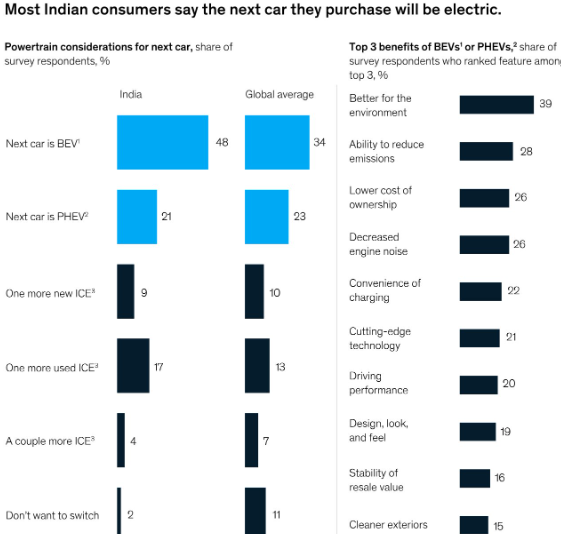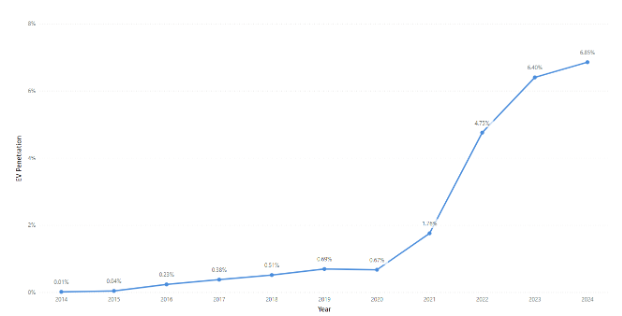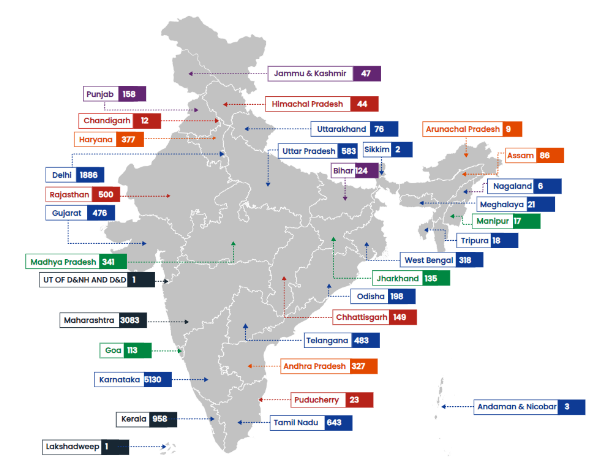Global EV car sales crossed the 40 million mark last year, with nearly 14 million new electric cars sold in 2023 alone. Of these, over 95% are registered in China, Europe, and the US.
For those of us here in India, these figures raise a curious question: Where does India stand in the world of electric vehicles? Or rather, Is India even ready for electric vehicles yet?
Guess what? The answer is not very straight.
Don’t worry, though, as this blog will answer this question for you. Read on to learn everything about the current state of EVs in India, the imposing challenges, and how they contribute to India’s EV readiness.
Is India Ready For Electric Vehicles? – Quick Brief
India’s readiness for electric vehicles mainly depends on three factors: Demand, Supply, and Infrastructure.
Fortunately, demand is not an issue. According to a McKinsey survey, over 70 percent of tier-one customers in India want to consider electric vehicles for their next purchase. In other words, Indians are pretty interested in electric vehicles!

About 48% of respondents want a fully electric car for their next car purchase, while 21% want a plug-in hybrid car. (Source: McKinsey)
However, consumer willingness alone is not sufficient to prepare India for electric vehicles. While the current state of EVs in India is on a positive growth curve, the country faces some big hiccups on its path to becoming completely EV-ready.
Let’s first look at the current state of EVs in India.
The Current State Of Electric Vehicles In India
The Indian EV market has grown dramatically over the last five years. EV sales have soared from 130,000 in 2018 to over 1.5 million in 2023—an increase of over 11 times!

The share of EVs in the total vehicle sales in India has increased from 0.67% in 2020 to 6.4% in 2023. (Source: Clean Mobility Shift)
Here are some key aspects of the current Indian electric vehicle landscape.
1. Electric Two-Wheelers
New electric-only companies have been leading the Indian E2W sector. Companies like Ola Electric, Ather Energy, Okinawa Autotech, and others have been at the forefront, offering feature-rich E2W models and driving sales.
Traditional companies are not far behind. TVS Motor reported over 166,000 sales in 2023, the second-largest for any two-wheeler company in India. Hero Electric—Hero’s dedicated electric two-wheeler arm—is also making its mark.
2. Electric Four-Wheelers
Four-wheelers are not seeing high adoption the way two-wheelers are. They have also been growing, no doubt, but at a much slower pace.
While Tata Motors has come up with electric versions of its best-selling models like Tiago, Punch, and Tigor, Mahindra Electric’s eSUV model, XUV400, has quickly become one of the best eSUV options in the country.
3. Electric Three-Wheelers, Buses, And Other EVs
Electric three-wheelers are witnessing the most impressive adoption rates among all vehicle segments.
In 2023, electric 3-wheelers such as e-rickshaws accounted for over half of the total 3-wheeler sales! Clearly, the time is pretty close when all the three-wheelers on the road will be electric.
Buses and omnibuses have seen increased adoption over the last few years, especially since 2021. In fact, the sales of buses and other EVs doubled from 1,177 in 2021 to 2,666 in 2023 and are set to surge further this year.
4. Mass EV Adoption By Companies
Individual customers alone are not driving the adoption of EVs in India. Even renowned global companies like Amazon and domestic giants like Zomato are betting strongly on EVs.
In 2020, during a trip to India, Amazon’s CEO, Jeff Bezos, announced the rollout of electric delivery rickshaws in the country. The company also plans to employ 10,000 electric vehicles in its delivery fleet in India by 2025.
Well, Amazon is not alone. Zomato also plans to make its entire delivery fleet fully electric by 2030. The company has been collaborating with multiple EV companies like Gogoro, Zypp Electric, and SUN Mobility to strengthen its e-fleet and reach closer to its goals.
What Are The Challenges?
With so many things happening in the Indian EV industry, it may seem India is poised to see a fully electric future soon. However, there are many bumps on the path that make it not so smooth.
1. Limited Charging Infrastructure
As of February 2024, India has only 16,348 public charging stations. Most of these stations are located in big cities such as Delhi, Bangalore, and Mumbai.

Public charging stations in India as of June 2024. (Source: Bureau of Energy Efficiency, Ministry of Power, India)
However, according to a report by the Confederation of Indian Industry, India needs around 1.32 million charging stations by 2030. At the present rate, achieving this target is a far-fetched possibility!
2. Battery Manufacturing Issues
Lithium is a core component of an EV battery. However, India almost entirely depends on imports to meet its lithium needs.
Some key lithium deposits have recently been discovered in Jammu and Kashmir (5.9 million tonnes), Karnataka (1600 tonnes), and Jharkhand. However, India lacks the infrastructure to convert this lithium into battery-grade lithium.
Considering that EV batteries make up about half the cost of EVs, the lack of a proper lithium processing infrastructure is a massive roadblock in India’s journey towards a fully electric future.
3. Not Enough Budget-friendly Vehicle Models
While electric 3-wheelers have already penetrated over half of the EV sales, electric 2-wheelers and 4-wheelers in India still have a long way to go. And the cost is one of the biggest speed-breakers.
EVs generally cost more upfront than comparable ICE vehicles with the same range. The price difference is even more pronounced for 4-wheelers, as only a handful of companies offer electric models, many of which are not budget-friendly.
There is a noticeable lack of affordable options. Customers today face confusion comparing the cost of ownership of EVs with that of ICE vehicles.
4. Post-purchase Service Quality
While EVs are gaining momentum in the Indian market, they are still a relatively new concept. EV-related issues are lesser known, and the current post-purchase services are not ready for these unfamiliar issues.
A tier-2 city in India has an average of 2-3 EV service centers. These handful of centers are the only resort when an EV faces issues.
If a traditional vehicle faces issues, you can go to an official center or a substitute repair center to get it fixed. But if your EV has problems, you can only go to an official service center as there are no alternative options.
With these challenges, is India really ready to go fully electric? The answer is far from YES.
Read More Related To EVs:
Conclusion: EV-ready India Has A Long Way To Go!
Due to all these challenges, India still has a long way to go before becoming completely EV-ready. Nevertheless, the future of EVs looks bright in India.
The Indian government is keen on promoting EVs. The GST on EVs with included batteries is only 5% compared to 28% on ICE vehicles. The government is also offering subsidies on EVs via FAME-2 and other schemes.
Global companies like Tesla, LeapMotor, and Stellantis also plan to enter the Indian market soon, indicating a positive future for EVs in the country.
Amid these developments, one thing is certain: EVs are the future of vehicles in India, just as they are in the rest of the world.